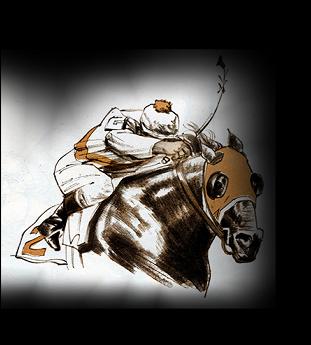by Eddie Arcaro
(Sports Illustrated Part 5, "The Finish" July 15, 1957)
THE FINISH
Although is correct to say that every foot of the way is important to each race, it's a fact that nine times out of ten, the money is waiting for the horse and jock who gets the best job done from the 1/8th to the wire. It is during these last 200 yards that I prefer to forget my whip and give my horse, instead the benefit of what we call the "hand ride". Now, basically what a rider does in the hand ride is to tune himself completely with the motion and rhythm of his horse. Thus, when the horse is on his hind feet, you must be in position to shove with your hands. And, as he pushes off on his jump, you go with him with your hands.
FORWARD THRUST
I think you will see from three drawings on this page what I mean when I say that you must be "one" with your horse in the proper hand ride. First of all, on the top of this page, we see a horse coming off his hind feet into his jump or big stride. As he makes his jump, I'm going forward with my hands, as seen to the right. Notice two things about my seat in this sequence: I'm well forward where I'm getting better leverage, and my short right iron is responsible for giving me the very strongest pushing action.
FULL OUT
Naturally, you must push as hard as your power will permit you to. The harder you push, the more you feel you're urging your horse--and helping him. On the right, you see the horse coming back from the jump, and consequently, my hands are also coming down. One aspect to the hand ride is that I notice that I get more power with my head down in an all-out drive. Of course, if you're driving in the middle of a pack you absolutely must (unlike this drawing) keep your head up to see where you're going.
NEUTRAL POSITION
Even with your head buried in your horse's neck and mane as your posture becomes more streamlined, you should be capable of maintaining the proper hand ride without breaking the rhythm with you've established between you and the horse. At the right, for example, I've already completed one full forward jump and my hands now come back to the neutral position after recoiling and we're about to start another in the strenuous series of push-and-thrust actions which make up the complete hand ride.
RELATIONSHIP WITH THE HORSE
Hand riding, of course, is riding with complete disregard of the whip. The hand ride, properly executed, is really just an all-out concentration of pushing along the horse's neck. There's only one way to hand-ride: get down and really shove at the thing. When you do it right, it's everything your body can give. You're straining every muscle in your body and the key to the whole business is that you must have that absolute relationship with the horse. For instance, if he's on his hind feet and I go forward before he takes off, then I'm riding faster than he's going--and we're not in motion together. The logical result of this will be that I'll completely confuse the horse. And a confused hose--no matter how potentially good a runner he may be--can't possibly give you his best effort. In fact, he's liable to quit on you.



















